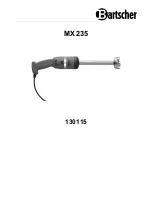
20
E N G L I S H
hat, or hearing protection used for appropriate
conditions will reduce personal injuries.
c Prevent unintentional starting. Ensure the
switch is in the off position before connecting
to power source and/or battery pack, picking
up or carrying the tool.
Carrying power tools
with your
fi
nger on the switch or energising power
tools that have the switch on invites accidents.
d Remove any adjusting key or wrench before
turning the power tool on.
A wrench or a key
left attached to a rotating part of the power tool
may result in personal injury.
e Do not overreach. Keep proper footing and
balance at all times.
This enables better control
of the power tool in unexpected situations.
f Dress properly. Do not wear loose clothing or
jewellery. Keep your hair, clothing and gloves
away from moving parts.
Loose clothes, jewellery
or long hair can be caught in moving parts.
g If devices are provided for the connection of
dust extraction and collection facilities,
ensure these are connected and properly
used.
Use of dust collection can reduce
dust-related hazards.
4 Power Tool Use and Care
a Do not force the power tool. Use the correct
power tool for your application.
The correct
power tool will do the job better and safer at the
rate for which it was designed.
b Do not use the power tool if the switch does
not turn it on and off.
Any power tool that
cannot be controlled with the switch is dangerous
and must be repaired.
c Disconnect the plug from the power source
and/or the battery pack from the power tool
before making any adjustments, changing
accessories, or storing power tools.
Such
preventive safety measures reduce the risk of
starting the power tool accidentally.
d Store idle power tools out of the reach of
children and do not allow persons unfamiliar
with the power tool or these instructions to
operate the power tool.
Power tools are
dangerous in the hands of untrained users.
e Maintain power tools. Check for misalignment
or binding of moving parts, breakage of parts
and any other condition that may affect the
power tools operation. If damaged, have the
power tool repaired before use.
Many accidents
are caused by poorly maintained power tools.
f Keep cutting tools sharp and clean.
Properly
maintained cutting tools with sharp cutting edges
are less likely to bind and are easier to control.
g Use the power tool, accessories and tool bits
etc., in accordance with these instructions,
taking into account the working conditions
and the work to be performed.
Use of the
power tool for operations different from those
intended could result in a hazardous situation.
5 Service
a Have your power tool serviced by a quali
fi
ed
repair person using only identical replacement
parts.
This will ensure that the safety of the
power tool is maintained.
Additional Safety Instructions for Drills
●
Wear ear protectors with mixers.
Exposure to
noise can cause hearing loss.
●
Use auxiliary handles supplied with the tool.
Loss of control can cause personal injury.
●
Hold power tool by insulated gripping
surfaces when performing an operation
where the cutting tool may contact hidden
wiring or its own cord.
Contact with a "live"
wire will also make exposed metal parts of the
power tool "live" and shock the operator.
Residual Risks
T he following risks are inherent to the use of drills:
– Injuries caused by touching the rotating parts or
hot parts of the tool.
In spite of the application of the relevant safety
regulations and the implementation of safety
devices, certain residual risks cannot be avoided.
These are:
–
Impairment of hearing .
– Risk of squeezing fingers when changing
accessories.
– Health hazards caused by breathing dust
developed when working in wood.
– Risk of personal injury due to flying particles.
– Risk of personal injury due to prolonged use.
Содержание D21510
Страница 1: ...www eu D21510 ...
Страница 3: ...1 5 7 2 4 1 3 6 A ...
Страница 4: ...2 B C1 C4 3 8 C2 C3 ...
















































